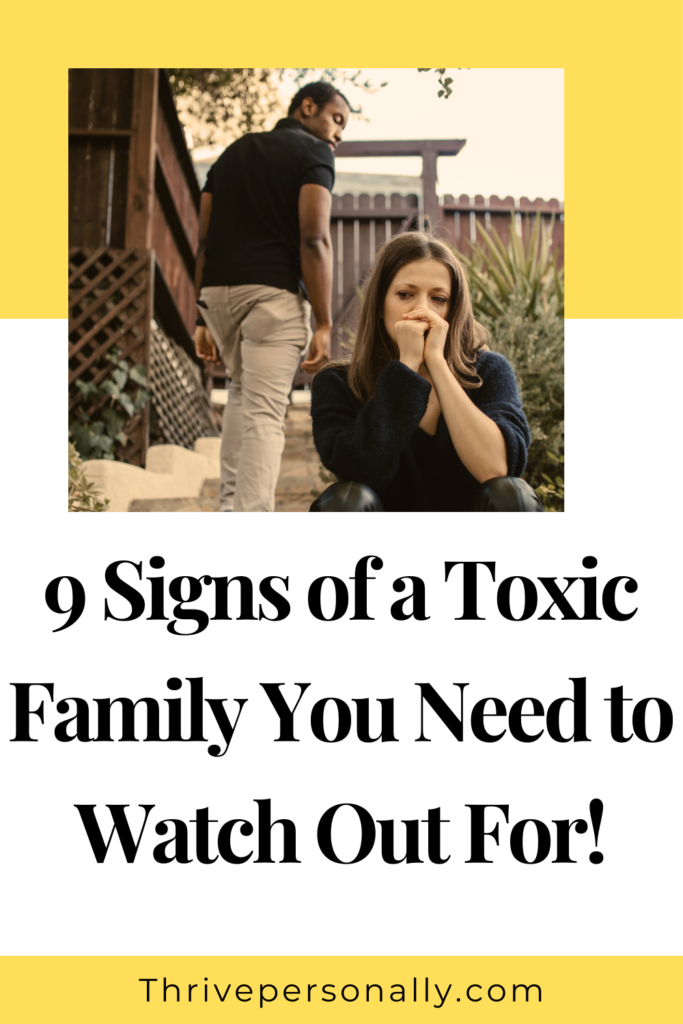Toxic family dynamics refer to unhealthy patterns of behavior and interaction that can pervade family relationships. Such dynamics often manifest as emotional, psychological, or even physical abuse, creating an environment that can be detrimental to the well-being of its members.
A significant aspect of toxic families is that they may appear normal or functional on the surface, making it difficult for individuals to recognize and acknowledge the underlying issues. This underlines the importance of exploring and identifying the traits that characterize these dysfunctional interactions.
Recognizing toxic family dynamics is crucial for fostering healthier relationships. The impact of these dynamics can extend beyond simply feeling unhappy; they can lead to long-term psychological effects such as low self-esteem, anxiety, and depression.
9 Signs of a Toxic Family You Need to Watch Out For
Sign 1: Constant Criticism and Judgment
In many families, the dynamics can heavily influence an individual’s emotional well-being. One predominant sign of a toxic family environment is the prevalence of constant criticism and judgment. This behavior often manifests as negative comments about personal choices, appearance, or even character, leading individuals to question their self-worth.
Unlike constructive criticism, which aims to support personal growth by providing helpful feedback, constant negative remarks serve no constructive purpose. They often stem from an underlying need to control or belittle, creating an unhealthy atmosphere.
The distinction between constructive criticism and judgment lies primarily in intent and impact. Constructive criticism tends to be specific, focused on behaviors rather than the person’s character, and delivered with care.
For example, suggesting improvements in a certain area while encouraging an individual’s strengths promotes a sense of empowerment. Conversely, constant criticism involves generalizations and derogatory comments, portraying the individual in an unflattering light and fostering feelings of inadequacy.
Read Also: How to Stop Being Toxic: 9 Tips That Can Change Your Life
Sign 2: Lack of Support and Encouragement
A pivotal characteristic of a toxic family is the notable absence of emotional support and encouragement among its members. Families are ideally expected to be a safe haven, providing a nurturing environment where individuals can thrive and feel valued. However, when this foundation is lacking, it can lead to significant emotional distress. Individuals in such families often experience feelings of isolation, as they struggle to find affirmation or recognition of their achievements.
The lack of support may manifest in various ways. For instance, when one family member is striving to pursue personal goals, such as education or career advancement, others may exhibit indifference or even overt criticism. This dismissive attitude not only undermines the individual’s self-confidence but can also perpetuate a sense of inadequacy. Over time, the affected member might internalize these negative sentiments, leading to deeper psychological issues, such as anxiety or depression.
Additionally, the absence of encouragement can stifle personal growth. Without a supportive network that celebrates successes, no matter how small, individuals are less likely to take risks or pursue their passions. They may become hesitant to express their feelings or share their achievements, further entrenching a culture of silence and dissatisfaction in the family dynamic. As a result, the feeling of being upheld in one’s endeavors is replaced with a pervasive sense of discouragement.
Read Also: 27 Deep Questions to Help You Discover Your Life Purpose
Sign 3: Manipulation and Gaslighting
Manipulation and gaslighting are psychological tactics often employed by individuals in toxic family environments to control and undermine others. Manipulation can involve a range of behaviors aimed at influencing someone’s emotions or actions for the manipulator’s advantage.
This can manifest through guilt-tripping, emotional blackmail, or playing the victim. In a toxic family setting, these tactics serve to establish an imbalance of power, often leading the manipulated individual to feel responsible for the manipulator’s feelings and actions.
Gaslighting is a more insidious form of manipulation, where the manipulator twists information or events to make the victim question their perception of reality. This tactic is derived from the 1938 play “Gas Light,” where a husband drives his wife insane by subtly altering elements of their environment and denying her experiences.
In toxic families, gaslighting can include denying past events, dismissing valid feelings, or framing situations in a way that confuses the victim. Such behaviors can erode a person’s self-esteem and lead to significant anxiety and self-doubt.
Common manipulative tactics found in dysfunctional family dynamics can range from overt aggression to more subtle forms of persuasion. For instance, a parent may invalidate a child’s feelings by stating, “You’re overreacting,” or “You should be ashamed of yourself,” placing the burden of emotional regulation on the child rather than acknowledging their distress. In navigating these complicated family dynamics, individuals often find themselves questioning their own judgment and retreating emotionally, which perpetuates the cycle of toxicity.
Read Also: How to Boost Your IQ: Simple Daily Habits to Try
Sign 4: Poor Communication Patterns

Effective communication serves as the cornerstone of healthy family dynamics. However, in toxic families, poor communication patterns often prevail, leading to misunderstandings and unresolved conflicts. Dysfunctional styles such as yelling, stonewalling, or passive-aggressiveness create an environment that stifles open dialogue and emotional expression.
Yelling is one of the most overt signs of poor communication. When family members resort to raised voices, it typically indicates heightened emotions and escalating tensions. This aggressive form of interaction can intimidate others, making them feel unsafe to express their thoughts and feelings. As a result, instead of fostering understanding, yelling often leads to deeper rifts within the family unit.
Stonewalling, or the act of withdrawing from a conversation, is another negative communication pattern seen in toxic family environments. When one member refuses to engage or acknowledge another’s concerns, it can leave unresolved issues festering beneath the surface.
This can lead to feelings of isolation or resentment, as the ignored party feels unheard and undervalued. Over time, this withdrawal can create a vicious cycle where open communication is discouraged, perpetuating unresolved conflicts.
Passive-aggressiveness is a more subtle yet equally damaging aspect of poor communication. It often manifests through indirect comments, sarcasm, or sabotaging behaviors rather than confronting issues directly. This style breeds confusion and conflict, as family members may struggle to discern the true feelings driving such behavior. Furthermore, it can create an atmosphere of distrust, where family members are unsure of what to expect from one another.
Sign 5: Control and Dominance
Within a family structure, it is essential for all members to experience a degree of autonomy. However, in toxic families, certain individuals often exhibit controlling and dominant behaviors that can significantly undermine this essential aspect of healthy family dynamics. Control can manifest in various ways, from overt manipulation to subtle coercion, limiting the freedom of expression and decision-making of others.
A common sign of control is the dictation of choices regarding personal matters, such as relationships, career paths, or daily activities. Family members who exert dominance may frequently make unilateral decisions, disregarding the opinions and desires of others.
Comments like, “You should do it this way,” or “I don’t think that’s a good idea,” are examples that illustrate this controlling behavior. Furthermore, such individuals often pressure their relatives to conform to their expectations, leading to a stifling environment where dissent is neither welcomed nor tolerated.
The ramifications of control within a family unit can be significant, leading to diminished self-esteem and increased anxiety among those subjected to it. Victims of controlling behavior may feel as though they lack agency over their lives, resulting in a pervasive sense of helplessness.
Over time, this can contribute to mental health challenges, including depression and heightened levels of stress, as individuals grapple with the internal conflict generated by unmet needs for autonomy.
Sign 6: Lack of Boundaries
Personal boundaries are essential components of healthy family dynamics, serving as the invisible lines that delineate individual needs, feelings, and responsibilities. When these boundaries are not respected, the family environment can quickly become toxic, leading to feelings of violation and resentment among members. A lack of individual space can manifest in various ways, whether through intrusive behaviors, excessive criticism, or a disregard for personal choices.
Families lacking boundaries often exhibit behaviors where one member’s opinions overshadow those of others, forcing conformity rather than encouraging individuality. This can lead to an oppressive atmosphere where family members feel constrained, resulting in an inability to express themselves freely. In such scenarios, emotional blackmail may also be prevalent, with one member leveraging guilt to control another’s decisions, thus infringing upon personal autonomy.
Another indication of boundary issues within a family is when personal privacy is consistently violated. This includes the reading of private messages, listening to phone calls, or invading personal spaces. Such actions can erode trust and create an environment filled with anxiety and discomfort. Furthermore, emotional boundaries may suffer as well, with family members feeling obligated to share their feelings or experiences even when they are not ready or willing to do so.
Sign 7: Emotional Instability
Emotional instability within a family can profoundly impact the dynamics and well-being of all its members. When one or more family members frequently exhibit emotional volatility, it creates a chaotic atmosphere that can evoke stress, anxiety, and confusion. Individuals dealing with emotional instability may experience rapid mood swings, irrational outbursts, and difficulty managing stress, leading to an unpredictable home environment.
Family members living with individuals who struggle with emotional challenges often find themselves in a constant state of alertness. They may feel compelled to tiptoe around the unstable individual, avoiding triggers that could provoke an outburst or evoke negative emotions. This can stifle healthy communication and prevent family members from expressing their feelings or addressing conflicts, leading to unresolved issues and resentment.
The effects of emotional instability can extend beyond individual family members. When tensions run high, relationships among other family members can become strained. Support systems may be undermined, and the emotional needs of individuals seeking stability may be overlooked.
Children, in particular, can be profoundly affected as they absorb and learn from the emotional dynamics presented to them. Growing up in a home characterized by emotional turbulence can result in long-term consequences, including difficulties in establishing healthy relationships and managing emotions in their own lives.
Sign 8: Enmeshment and Codependency
Enmeshment and codependency are two significant dynamics often found in toxic family relationships. Enmeshment occurs when family members become overly involved in each other’s lives, resulting in a blurred line between personal identities. In such scenarios, individual boundaries dissolve, leading to a lack of autonomy among family members.
This phenomenon can stifle personal development, as individuals may feel obligated to prioritize family needs over their own. When a family operates in an enmeshed manner, it creates an environment where each member’s identity feels intertwined with others, generating confusion over personal desires and goals.
Codependency is frequently intertwined with enmeshment, where one or more family members exhibit excessive reliance on each other for emotional or psychological support. This dependency creates a dysfunctional cycle, often manifested in behaviors such as enabling or sacrificing one’s own needs for the sake of another.
For instance, a parent might emotionally rely on a child for validation, thereby placing an undue burden on the child to fulfill adult emotional needs. Conversely, a child may feel compelled to care for their parent, sacrificing their own happiness in the process. Such relationships foster unhealthy attachments, where individuals struggle to separate or define their personal identities.
Sign 9: History of Abuse or Neglect
A history of abuse or neglect within a family serves as a crucial indicator of a toxic environment. Such experiences can leave lasting emotional and psychological scars on individuals, often influencing their behaviors and relationships in profound ways.
Abuse can take various forms, including physical, emotional, verbal, and sexual, while neglect might manifest as a lack of attention, care, or support. When these patterns are present in a familial setting, they create a breeding ground for dysfunction and distress.
The impact of experiencing or witnessing abuse or neglect is far-reaching. Survivors may struggle with low self-esteem, anxiety, depression, or even post-traumatic stress disorder (PTSD). These emotional challenges can lead to difficulties in forming healthy relationships and can perpetuate cycles of toxicity that span generations. Children raised in such environments may inadvertently adopt the same harmful behaviors they experienced, further entrenching toxic dynamics within the family unit.
Addressing abuse or neglect is imperative for breaking this cycle. It is crucial for individuals to seek professional help or therapeutic support to process their experiences and heal. Family therapy can also play a significant role in uncovering deep-rooted issues and fostering open communication among family members. By acknowledging the history of abuse or neglect, families can begin to understand the importance of change and growth for everyone involved.
Save the pin for later



